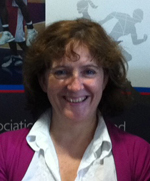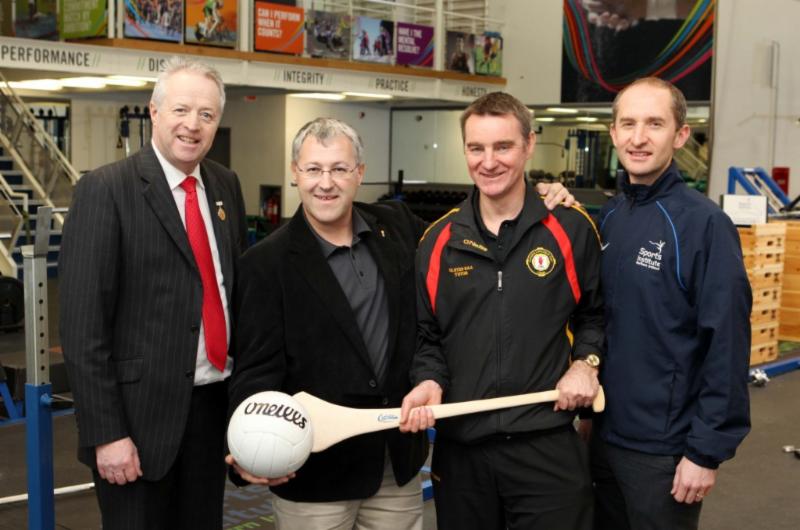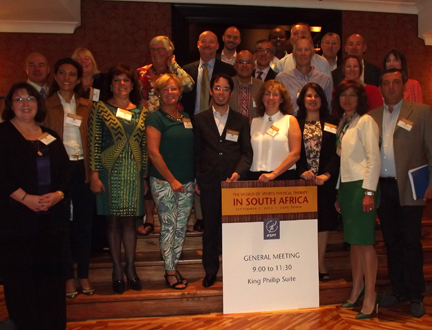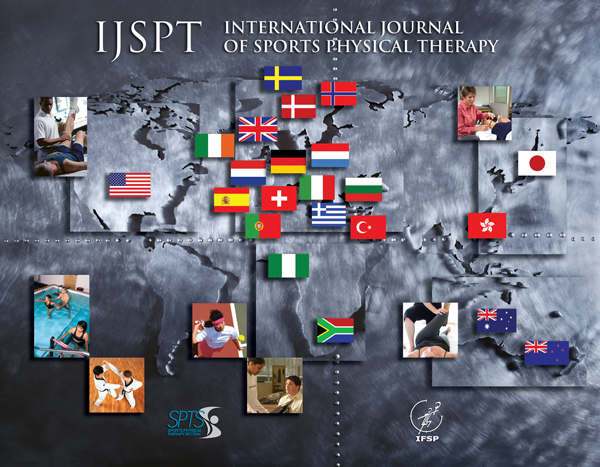|
About the IFSPT
IFSPT is a world-wide Federation, recognised as a subgroup of the World Confederation for Physical Therapy (WCPT), representing national organizations of Sports Physiotherapy. The efforts of IFSPT are directed towards Member Organizations and their individual members in serving athletes of all ages and abilities through excellence in education, research, practice, and clinical specialisation. The intention of the IFSPT is to be the international resource for Sports Physical Therapists all over the world.
FIND US...
ONLINE
ON FACEBOOK
|

Help your colleagues stay connected to the IFSPT! Forward this publication to them via e-mail and encourage them to register to receive our e-magazine. Signing up takes only a few moments! |
|
|
|
Many Apologies...
We are re-sending the newsletter because of a break in the link to the New Zealand group's website and late-received information regarding their upcoming symposium.
Sport Physiotherapy New Zealand may be found at this link.
Information on the symposium to be held in Rotorua on March 15-16 may be found at this link.
Thank you for your attention!
|
|
The President's Corner

Welcome to the Spring 2014 edition of the IFSPT newsletter.
Once again it's been a busy period for many of our members, with the Winter Olympics and Paralympics in Sochi being a particular highlight for those of us watching from afar. As always, I'm sure it was a lot of hard work for the physios working there and we hope that a few of you will send us your reflections to publish in the next edition.
Our IFSPT practitioner registration process is now gaining momentum since its launch and we are receiving more applications or expressions of interest every week. There are more details about how to get started in this edition. We're also starting to get involved in helping those countries looking to develop a national pathway that will link in to this registration, and I look forward to working with those who have already got in touch for advice on putting a programme together. For those member countries who are still considering whether to pursue this, we are already seeing a benefit to your national organisations as we only accept applications from those who are existing members of the relevant sports physical therapy group in their country, and we have already referred a good number of individuals back to their national organisations.
Judging by the reports and blogs that have been published, there have been some great conferences in that last few months, with more to come - there are some details of what's on later in the newsletter. Don't forget to let us know what's on in your country and we will post it on our website and in our social media. Thanks also to members who have sent in some clinically related blogs, also in this newsletter - keep them coming!
As I write this, we are preparing for our upcoming Executive Board meeting to be held in London, when, amongst other things, we will be making a decision on where we will hold the 2015 GM. As a committee we are very mindful of the expense of travelling to these meetings so will be continuing our strategy of trying to spread these around so that the travel burden is varied over the years. We've had a lot of interest, which is great to see, and we will certainly look to support all those conferences through advertising and helping find speakers, regardless of the final decision on the GM.
Don't forget to keep in touch via our website www.ifspt.org, Facebook and follow us on Twitter @IntFSPT!
Dr. Nicola Phillips, President, IFSPT
|
SINI and Ulster GAA Launch Major Injury Prevention Initiative
Courtesy of Sports Institute of Northern Ireland
...................................................................................
 Martin McAviney, Ulster GAA President, Dr Mario Bizzini, F-Marc, Roger Keenan, Coaching Development Manager Ulster GAA, and Prof. Phil Glasgow Head of Sports Medicine, SINI. Martin McAviney, Ulster GAA President, Dr Mario Bizzini, F-Marc, Roger Keenan, Coaching Development Manager Ulster GAA, and Prof. Phil Glasgow Head of Sports Medicine, SINI.
Sports Institute Northern Ireland (SINI) and Ulster GAA (Gaelic Athletic Association) have unveiled an innovative warm-up programme designed to enhance performance and reduce injury.
The Activate GAA Warm-up has been adapted from FIFA's successful 11+ programme to meet the specific needs of GAA sport and to reduce the incidence of common lower limb injuries among players, particularly Anterior Cruciate Ligament (ACL).
It was launched officially at Ulster GAA's annual coaching conference on Saturday 1st February, when Dr Mario Bizzini of FIFA's Medical Research Centre delivered the keynote speech. Activate will then be rolled out to clubs and counties across Ulster in 2014.
The Activate Warm-Up has been developed by SINI in conjunction with Ulster GAA coaches and an expert group of sports medicine professionals. It is based on solid medical research and, if performed regularly with proper technique, it can lead to a reduction in leg injuries by up to 50%.
Roger Keenan, Coaching Development Manager at Ulster GAA comments:
"Injury prevention is a massive priority for Ulster GAA and we see Activate as a vital part of our player welfare strategy. It's a fantastic initiative that has come about as a result of a big demand within GAA circles for a warm-up that is consistent and uniform. The warm up will actually lead to better functional movement and a reduction in injury and it's a great example of how Ulster GAA's collaboration with SINI continues to deliver real benefits for our coaches and players."
The initiative is supported by an online coaching resource, activategaa.sini.co.uk, featuring videos of players from all four GAA codes including Donegal's All Ireland winning captain Michael Murphy and Armagh Ladies star Caroline O'Hanlon being coached through the routine.
Michael Murphy believes that the Activate Warm-Up will prove to be a vital intervention:
"The warm-up teaches players better functional movement and sprint mechanics and encourages good technique; it's fantastic that Ulster GAA and SINI have had the vision to create it. I'd urge every club and county across Ulster to get in on this now and educate their players."
Head of Sports Medicine at SINI, Prof. Phil Glasgow comments:
"This was a real collaborative effort between SINI, the Ulster Council and experienced medical and physiotherapy staff from the counties. We've trialled it with many coaches and they're reporting really positive results. So, we're confident Activate will help reduce the incidence of ACL injury and actually aid performance because it's built around the key skills and movement patterns needed when playing Gaelic sport".
Dr Mario Bizzini of the FIFA Medical Research Centre comments:
"Injury prevention warm ups have become a central part of sports practice and have been shown to effectively reduce injury. The Activate GAA Warm-up is an excellent example of a sport specific warm-up that will not only effectively prepare the players but also reduce common injuries."
Dr Bizzini is a board member of the International Federation of Sports Physical Therapy.
|
|
INTERNATIONAL SPORTS PHYSICAL THERAPIST REGISTRATION NOW AVAILABLE IN SEVEN MEMBER ORGANIZATIONS FOR
IMMEDIATE REGISTRATION.
...................................................................................
 If you would like to take your skills to the world, this is the pathway you should choose! Registered International Sports Physical Therapists (RISPT) are immediately recognized as individuals possessing the knowledge, experience and skills to work in the worldwide field of sports. While RISPT status does not license an individual in other countries, it does notify that the individual has achieved the highest level of qualification in his or her country. Currently, members of the following member organizations are able to apply and receive acceptance immediately. - Australia
- Denmark
- Ireland: Irish Society of Chartered Physiotherapists, Level 3 Accreditation in Sports Physiotherapy
- New Zealand: Complete the Specialisation Pathway through the Physiotherapy Board of New Zealand. Must complete specialisation in the Musculoskeletal Category with the subcategory area of specialisation in Sports Physiotherapy
- The Netherlands
- United Kingdom: Continuing Professional Development Level 3, Gold
- United States: APTA Sports Certified Specialist
Cost for registration is only 50 euros and is good for five years. Renewal is available for 20 euros. A certificate will be emailed to you in order that you may print and display it. IMPORTANT REGISTRATION LINKS:
Register today and be recognized for your accomplishments as an international sports physical therapist!
|
|
FUTURE CONFERENCES: PLAN NOW!
..................................................................................................................

Exercise Across the Lifespan
Sports Physiotherapy Symposium 2014
March 15-16 Millennium Hotel Rotorua Sponsored by Sports Physiotherapy New Zealand
Football Medicine Strategies for Joint & Ligament Injuries
 "Let's Get Physical"
ACPSEM Study Day
Saturday, March 29, 2014
University of West of England, Bristol
Speakers:
- Dr Pippa Bennett
- Dr Nicola Phillips
- Dr Rod Jaques
- Dr Mark Tully
- Chris Worsfold
- Dr M Polly McGuigan
- Dr Ruth Jones
For more information and to register, follow this link
Sportfisio Switzerland
Annual Conference
Bern, Switzerland
November 21, 2014
Save the Date
Team Concept Conference 2014
December 4-6
Green Valley Ranch Resort
Las Vegas, Nevada - USA
Save the Date: Registration available soon
Attention Member Organizations:
Are you sponsoring a physical therapy, sports physical therapy or sports medicine conference in 2013?
Please send the information regarding your conference to Mary Wilkinson, IFSPT marketing director, for addition to the IFSPT newsletter and website! Newsletters are published each month, so please submit your material as early as possible. You are also welcome to provide updates as your event draws closer!
|
|
Now Available: The IFSPT Blog!
Join us on our new IFSPT Blog! If you have experiences in sports physical therapy to share, we've established a blog page on our website. Lots of our members are working in some incredible areas - let's start sharing what we learn from these events. We've created the forum...now we need you to participate! Go to this link and post your thoughts, questions, tips and tricks! |
|
HOW ARE YOU PARTICIPATING IN THE IJSPT?
...................................................................................
 The International Journal of Sports Physical Therapy is an official publication of the IFSPT. Our member organizations, as well as our international organization, gain great benefits through participation in the IJSPT. Truly a forum for the international sports physical therapy field, the IJSPT is indexed in PubMed and CINAHL, and has featured articles from writers in over twenty countries. Member organizations are expected to participate in the Journal in one of three ways:
Option One: Provide the Journal as a member benefit to all members of the organization (a roster and payment is submitted annually to the managing editor), and promote the Journal on the web and in member communications. Option Two: Provide the Journal as a member benefit to members choosing to participate, submit a roster and payment to the managing editor annually, and promote the Journal on the web and in member communications. Option Three: Promote the Journal on the web and in member communications, directing members to the IFSPT subscription link (select "IFSPT member" for a 60% discount). If your organization would like to change its participation level, please contact Mark DeCarlo. For marketing information or tools, please contact Mary Wilkinson.
|
|
LEARN AT YOUR CONVENIENCE...WHEREVER YOU ARE! HOME STUDY COURSES NOW AVAILABLE TO IFSPT MEMBERS AT DISCOUNT
...................................................................................
 No time to participate in conferences outside your clinic? No travel budget? No time for classroom study with family commitments? The IFSPT has approved the SPTS Home Study Courses for credits toward International Sports Physical Therapy Registration...and IFSPT members receive a generous discount. Courses may be purchased and downloaded immediately...you can start learning right away. Offered in a convenient downloadable format, each Home Study Course (HSC) consists of multiple chapters (monographs) along with a final examination. Chapters are approximately 15-30 pages in length and require 4 to 6 hours to complete. The final examination consists of approximately 5 questions from each chapter. To receive continuing education credit, HSC participants must complete the final examination and return the answer sheet to the SPTS home office via email or fax. A course certificate will be sent to the course participant upon successful completion of the final examination. Editor: Teresa L. Schuemann, PT, DPT, SCS, ATC, CSCSChapters:Chapter 1: Pre-participation Screening for the Female Athlete
Barbara Sanders, PhD, PT, SCS, FAPT
Brenda Boucher, PhD, PT, OCS, CHT, FAAOMPT Chapter 2: Medical Considerations for the Female Athlete
Teresa L Schuemann DPT, SCS, ATC, CSCS Chapter 3: Prevention of Lower Extremity Injury in the Female Athlete
Lori A Bolgla, PT, PhD, MAcc, ATC Chapter 4: Management of Lower Extremity Dysfunction in the Female Athlete
Janice Loudon PT, PhD, ATC, SCS Chapter 5: Management of Upper Extremity Dysfunction in the Female Athlete
Marisa Pontillo PT, DPT, SCS Chapter 6: The Spine in Sport: Considerations for the Female Athlete
Barb Hoogenboom, PT, EdD, SCS, ATC The SPTS Sports Certified Specialist Examination Preparatory CourseEditors: Robert C. Manske, PT, DPT, MEd, SCS, ATC, CSCS and Timothy Tyler, PT, MS, ATC Designed for preparation for the Sports Certified Specialist Examination in the United States, this fourteen-chapter course covers many areas the average clinician does not experience in daily practice. CURRENT CONCEPTS IN SHOULDER REHABILITATION Editor: Chuck Thigpen PT, PhD, ATC RUNNING Editors: Bryan Heiderscheit, PT, PhD and Mitchell J. Rauh, PT, PhD, MPH, FACSM PEDIATRIC AND ADOLESCENT SPORTS MEDICINE: MANAGEMENT AND PREVENTION OF INJURIES UNIQUE TO THE YOUNG ATHLETE Editors: Donna L. Merkel, PT, MS, SCS, CSCSand Joe Molony, PT, MS, SCS, CSCS CURRENT CONCEPTS IN EVALUATION, EXAMINATION AND REHABILITATION OF THE KNEE Editor: Robert C. Manske, PT, DPT, MEd, SCS, ATC, CSCS REHABILITATION OF THE HIP Editors: Lori Bolgla, PT, PhD, ATC and J. Craig Garrison, PT, PhD, SCS, ATC REHABILITATION OF ARTICULAR CARTILAGE INJURIES OF THE KNEE Editor: Timothy Tyler, PT, MS, ATC THE SPINE IN SPORTS Editor: Barb Hoogenboom PT, EdD, SCS, ATC INJURY PREVENTION IN SPORTS MEDICINE Editor: Mike Mullaney, PT REHABILITATION OF THE AGING ATHLETE Editor: J. W. Matheson, PT REHABILITATION CONCERNS FOR THE FEMALE ATHLETE Editor: Teresa L. Schuemann, PT, SCS, ATC, CSCS EMERGENCY RESPONSE FOR THE PHYSICAL THERAPIST Editor: Danny D. Smith, PT, DHSc, SCS, OCS, ATC Other courses are available. To learn more about these courses, follow this link to the SPTS website.COMING SOON!
Team Concept Conference Streaming Video: March 2014
|
|
FOAM ROLLING EFFECTIVE FOR BOTH WARM-UP AND RECOVERY
...................................................................................
Courtesy of the Thera-Band Academy, February 24, 2014
Myofascial foam rolling has become a popular tool as part of both warm-up and cool down prior to activity. Despite its popularity, little research has been performed on the mechanisms or efficacy of foam rolling.  Researchers at Memorial University in Canada have led the way with the first published studies on the effectiveness of foam rolling. In 2013, they published a paper in the Journal of Strength and Conditioning Research that found as little as 2 minutes of foam rolling on the quadriceps muscle increased knee range of motion by 10%, which was significantly more than a control group. In addition, they showed the immediate increase in flexibility did not affect muscle performance. These findings suggest foam rolling can increase range of motion as effectively as muscle stretching without the immediate decrease in performance seen with static stretching as part of a warm-up. Researchers at Memorial University in Canada have led the way with the first published studies on the effectiveness of foam rolling. In 2013, they published a paper in the Journal of Strength and Conditioning Research that found as little as 2 minutes of foam rolling on the quadriceps muscle increased knee range of motion by 10%, which was significantly more than a control group. In addition, they showed the immediate increase in flexibility did not affect muscle performance. These findings suggest foam rolling can increase range of motion as effectively as muscle stretching without the immediate decrease in performance seen with static stretching as part of a warm-up.
More recently, the Memorial University researchers published a paper in Medicine and Science in Sports and Exercise on the effects of foam rolling after intense physical activity as a recovery tool. The researchers wanted to investigate the effectiveness of foam rolling on delayed onset muscle soreness (DOMS) and identify potential mechanisms of action. They randomly assigned 20 healthy males with strength training experience to either a foam-rolling group or to a control group. Both groups performed squats to induce DOMS in their legs. The foam-rolling group then performed 5 different rolling techniques on their anterior, lateral, posterior, medial thigh, and gluteal muscles. They performed each of the 5 exercises on both legs for 60 seconds each, for a total of about 20 minutes. Foam rolling substantially reduced muscle soreness while also increasing range of motion compared to the control group. In addition, the foam-rolling subjects had improved vertical jump and muscle activation levels compared to the controls. In contrast, the control group suffered substantial deficits in muscle performance. Because there were no effects on isolated muscle function with the foam rolling, the researchers suggested that foam rolling might affect the neurological system and connective tissue more than the muscle itself. DOMS is thought to result from damage to connective tissue with resultant inflammation. In conclusion, the researchers stated, "The improved recovery rate in muscle soreness in the foam rolling group signifies that foam rolling is an effective tool to treat DOMS." REFERENCE: Macdonald GZ, et al. Foam rolling as a recovery tool after an intense bout of physical activity. Med Sci Sports Exerc. 2014 Jan;46(1):131-42.
|
Original Research:
Clinical Effectiveness of Kinesio taping on Pain and Pain-free Shoulder Range of Motion in Patients with Shoulder Impingement Syndrome: A Randomized, Double blinded, Placebo-controlled Trial
...................................................................................
Courtesy of the International Journal of Sports Physical Therapy
Authors: Shakeri H, Keshavarz R, Arab AM, Ebrahimi IBackground: Kinesiological taping (KT) is commonly used to improve symptoms associated with musculoskeletal disorders. However, review of the literature revealed minimal evidence to support the use of KT in treatment of shoulder disorders and controversy exists regarding the effect of KT in patients with shoulder impingement syndrome (SIS). Objective: The purpose of this study was to investigate the effect of KT on pain intensity during movement, pain experienced during the night (nocturnal pain), and pain-free shoulder range of motion (ROM) immediately after taping, after three days and after one week, in patients with SIS. Design: Randomized, Double blinded, Placebo-controlled design. Participants: A total of 30 patients with SIS participated in this study. Patients were assigned randomly to a control (N = 15) and an experimental group (N = 15). Methods: The patients in the experimental group received a standardized therapeutic KT. The standardized, placebo neutral KT was applied for control group. KT was applied two times with a three day interval, remaining on during the 3 day interval. Both groups followed the same procedures. Pain-free active ROM during shoulder abduction, flexion, and elevation in the scapular plane was measured. Visual analogue scale (VAS) for pain intensity during movement or nocturnal pain and was assessed at baseline, immediately after KT, after three days, and one week after KT. Results: The result of repeated measures ANOVA showed a significant change in pain level during movement, nocturnal pain, and pain-free ROM (p = 0.000) after KT in the experimental group. In the ANCOVA, controlling for pre-test scores, change in pain level at movement (p = 0.009) and nocturnal pain (p = 0.04) immediately after KT was significantly greater in the experimental group than in control group. There was no significant difference in ROM measures (p > 0.05) between groups immediately after KT. No significant differences were found between the two groups in the after one week measurements of pain intensity and shoulder ROM. Conclusion: The KT produces an immediate improvement in the pain intensity at movement and nocturnal pain in patients with SIS. Level of Evidence: 1 Key Words: Kinesiological taping, pain, range of motion, shoulder impingement Access Full Article Here
|
|
|
|
|
|
|